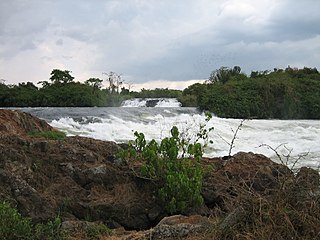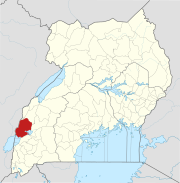
The Bujagali Power Station is a hydroelectric power station across the Victoria Nile that harnesses the energy of its namesake; the Bujagali Falls, in Uganda. Construction began in 2007 and concluded in 2012. It was officially inaugurated on 8 October 2012 by Ugandan President Yoweri Museveni and Aga Khan IV in the presence of African politicians and investors.

Kiira Hydroelectric Power Station, is a hydroelectric power station in Uganda, with an installed capacity of 200 megawatts (270,000 hp).
The Karuma Hydroelectric Power Station is a 600 MW hydroelectric power project under construction in Uganda. When completed, it will be the largest power-generating installation in the country.
Bugoye Power Station is a 13 MW (17,000 hp) mini hydroelectric power station in Uganda. In the literature, Bugoye Power Station is sometimes referred to as Mubuku II Power Station.
The Muzizi Power Station is a proposed 45 megawatts (60,000 hp) hydroelectric power project in Uganda. The project, which has been planned for several years, has received a funding commitment from KfW and the French Development Agency.
Ayago Hydroelectric Power Station, also Ayago Power Station, is a planned 840 megawatt hydroelectric power project to be constructed in Uganda. If it is built, Ayago would be the largest power station in Uganda, based on generating capacity.
Kikagati Hydroelectric Power Station, also referred to as Kikagati Power Station, is a 15.57 MW (20,880 hp) hydroelectric power station, in Uganda.
Mubuku III Power Station is a 10 megawatts (13,000 hp) mini-hydroelectric power station in Uganda.
Rwimi Hydroelectric Power Station, also Rwimi Power Station, is an operational 5.54 megawatts (7,430 hp) hydroelectric power station in the Western Region of Uganda.
Siti I Hydroelectric Power Station, commonly referred to as Siti Power Station, is a 5.0 megawatts (6,700 hp) mini hydropower station in Uganda.
Lubilia Hydroelectric Power Station, also Lubilia Kawembe Power Station, is a 5.4 MW hydroelectric power station in Uganda, the third-largest economy in the East African Community.
Tororo Solar Power Station, also Tororo Solar North Power Station, is a 10 megawatts (13,000 hp) solar power plant in Uganda, the third-largest economy in the East African Community.
Achwa 2 Hydroelectric Power Station is a 41 megawatts (55,000 hp) hydroelectric power plant, in Uganda.
Nyamagasani II Hydroelectric Power Station, also 'Nyamagasani 2 Hydroelectric Power Station, is a 5 megawatts (6,700 hp) mini hydro power station, under construction in the Western Region of Uganda.
The Nkenda–Fort Portal–Hoima High Voltage Power Line is a high voltage electricity power line, in operation, connecting the high voltage substation at Nkenda, Kasese District, to another high voltage substation at Kabaale, Buseruka sub-county, Hoima District, all in the Western Region of Uganda.
The Achwa 1 Hydroelectric Power Station (A1HPS), also Achwa I Hydroelectric Power Station, is a hydroelectric power station currently under construction (2020) in Uganda, with a planned installed capacity of 41 megawatts (55,000 hp).
Mpatamanga Hydroelectric Power Station, also Mpatamanga Power Station, is a planned 350 megawatts (470,000 hp) hydroelectric power project to be constructed in Malawi.
Nyamwamba II Hydroelectric Power Station, is a 7.8 megawatts mini-hydroelectric power station, that was commercially commissioned in March 2022 in Uganda. The run of river mini-hydroelectric installation is owned and was developed, between October 2019 and March 2022, by Serengeti Energy Limited, a Kenyan independent power producer (IPP), which was formerly called responsAbility Renewable Energy Holding (rAREH). The energy generated here is sold directly to the Ugandan electricity transmission parastatal company, Uganda Electricity Transmission Company Limited (UETCL), under a 20-year power purchase agreement (PPA). The power is integrated into the Ugandan national electric grid.
The Gribo–Popoli Power Station, also Gribo Popoli Power Station, is a hydroelectric power station under construction across the Sassandra River, in Ivory Coast. This renewable energy power station is owned and is under development by the Government of Ivory Coast, through its wholly owned subsidiary, CI-Energies, the national electricity utility parastatal company.



